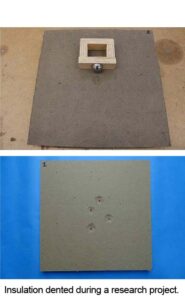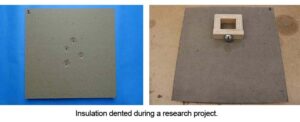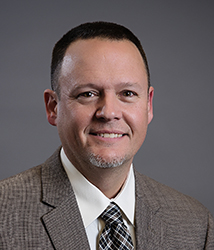HAIL DENTED MY ROOF INSUALTION – NOW WHAT?

Large hail falls onto a commercial building covered with a single-ply TPO roof membrane. A roof inspector scours the whole roof front to back and left to right and does not find any hail-caused ruptures, but then notices the insulation is dented…Now what?
Single-ply roofing membranes can be fractured or torn when impacted by hailstones; however, many single-ply systems can resist being damaged by hail (including large hailstones) when the roofing membranes are relatively new and in good condition. Most single-ply systems are installed directly over insulation boards and a hailstorm that doesn’t damage the membrane can still cause dents in the underlying insulation. Concerns often arise about the thermal performance of insulation after being dented by hail.
The thermal performance of insulation is typically quantified by its R-value, which is a measure of heat flow resistance. Heat flow is thermal energy passing through a space due to a difference in temperatures. For example, if a roof is hot on a sunny summer day and the space inside the building is air conditioned, there will be some amount of heat energy flowing into the building through the roof. Insulation on the roof reduces the rate of heat flow between the roofing and the roof decking, which reduces the heat flow into and/or out of the building.
Insulation R-value can be measured in a laboratory by using a heat flow meter (HFM). In order to determine if the R-value of insulation has been affected by hail-caused dents, samples of insulation can be removed from the roof and the R-value of dented and non-dented insulation can be measured and compared. Haag Research & Testing Co. (HRT) is currently studying the effects hail-caused dents have on the R-value of various types of roofing insulation and has performed R-value testing on numerous samples sent to the HRT laboratory.

HRT is accredited by International Accreditation Service (IAS) to perform ASTM C518 – Standard Test Method for Steady-State Thermal Transmission Properties by Means of the Heat Flow Meter Apparatus, and this test standard is followed by HRT when analyzing the thermal performance of roofing insulation.
Hail-dented insulation can be easily found in non-sheltered portions of the roof provided the hail was large enough and hard enough to cause detectible dents. Non-dented insulation can be difficult to find after a substantial hailstorm; however, some roofs have tall equipment or taller portions of the building that can shelter a region of the roof from wind-driven hail, which can be useful in finding a sample of non-dented insulation. In the event non-dented insulation cannot be obtained, the R-value of dented insulation can be measured, then a comparable dent can be added to the insulation and the R-value re-measured to reasonably determine if hail-caused dents had a measurable effect on the insulation R-value.
Tests performed on roofing insulation often show little or no measurable change on the insulation R-value due to hail-caused dents; however, if dents are sufficiently large, deep, or numerous, a subtle change in R-value can be measured. Also, very large hail can crack or rupture insulation, resulting in a thermal short through the insulation which can have a greater influence on the measured R-value. If concerns arise regarding the effects hail-caused dents had on the R-value of a roof, consider taking samples of the insulation for testing.
*More information on R-Value testing by Haag Research & Testing or contact us.


Steve R. Smith, P.E., is Director of Research & Testing and a Principal Engineer with Haag Global. He completed nuclear power training with the United States Navy in 1994. He was honorably discharged in 1998 and went to work for Haag Engineering Co. as Senior Laboratory Technician. Steve has performed hundreds of hail impact tests on a variety of products including roofing, siding, and automobiles. He graduated from the University of Texas at Arlington in 2005 with a Bachelor’s degree in Mechanical Engineering and is a member of the American Society of Mechanical Engineers, the Society of Automotive Engineers, and the National Association of Fire Investigators. Steve has inspected and assessed damage to a number of roof systems, including single-ply systems, composition shingles, cedar shake and shingles, concrete tiles, slates, and built-up roofing. As Director of Research & Testing, Mr. Smith oversees all testing projects, protocols, and manages Haag’s accreditation. Mr. Smith is based at Haag headquarters in Flower Mound, Texas.
Any opinions expressed herein are those of the author(s) and do not necessarily reflect those of Haag Engineering Co., Haag Construction Consulting, Haag Education, or parent company, Haag Global, Inc.

